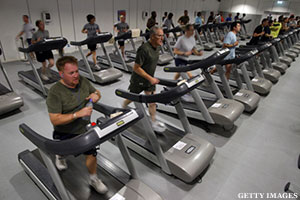
Missed the mark on your last trail run? If you've been training indoors, blame your treadmill.

According to a study published in the Journal of Strength and Conditioning Research, walking or running indoors requires less effort than moving at the same speed outdoors.
Researchers tracked how much energy 14 people ages 20 to 26 burned as they walked on a treadmill compared to walking outdoors, and found that choosing a 3 percent slope on the treadmill most accurately matched the energy requirements of walking on flat terrain outdoors.
That’s because running on rough or uneven terrain outdoors takes 10 percent more energy than plodding along on your smooth treadmill, says the study’s lead researcher, Luigi Fattorini, a professor at the Sapienza University of Rome. Throw in the wind and you really need to crank up the slope: If there's a gentle breeze at 9 miles per hour, you expend 5.5 percent more energy than you would without wind.
Your move: To prepare for a race, train at an incline of 3 percent or higher -- and when possible, train in the same type of shoe you plan to race in. (Need suggestions? Check out The Best Running Shoes For Men.) Researchers in the study had people wear running shoes on the treadmill, but measured their outdoor caloric burn while they wore trekking boots. Switching up your shoes can throw off your time since shoes with greater ankle support -- like most hiking boots and many trail running shoes -- limit your ankle flex, can make you less efficient, and force you to work harder.
Is running a good way lose weight? Find out if you're falling for one of these 5 Weight-Loss Myths.




